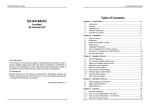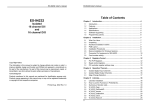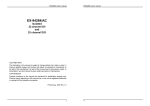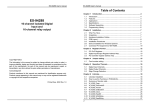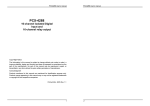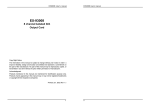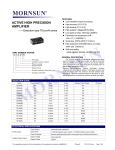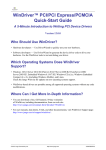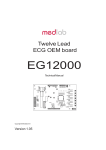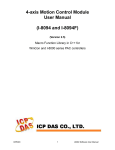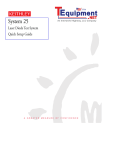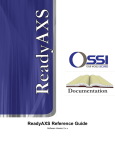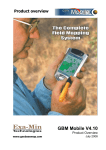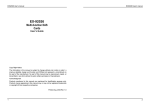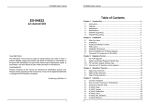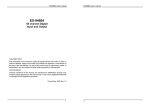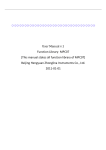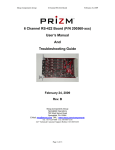Download Manual - TopsCCC
Transcript
EX-94132 user’s manual EX-94132 user’s manual Table of Contents EX-94132/AC Chapter 1 Introduction......................................................................................4 Isolated 32 channel D/I 1.1 1.2 1.3 1.4 1.5 Introduction ................................................................................................4 Features ....................................................................................................4 Specifications.............................................................................................5 Software Supporting ..................................................................................6 Programming Library .................................................................................6 Chapter 2 Installation........................................................................................7 2.1 2.2 2.3 2.4 2.5 2.6 2.7 2.8 What You Have ..........................................................................................7 Unpacking..................................................................................................7 Hardware Installation Outline .....................................................................7 PCB Layout................................................................................................8 Installation Procedures ..............................................................................9 Device Installation for Windows Systems ..................................................9 Connector Pin Assignment of EX-94132/AC..............................................10 Card number setting ..................................................................................11 Chapter 3 Registers Format .............................................................................12 Copy Right Notice The information in this manual is subject to change without prior notice in order t o improve reliability, design and function and dosed not represent a commitment on the part of the manufacturer. No part of this manual may be reproduced, copied, or transmitted in any form without the prior written permission of manufacturer. Acknowledgment Products mentioned in this manual are mentioned for identification purpose only. Products manes appearing in this manual may or may not be registered trademarks or copyright of their respective companies Printed Aug. 2002 Rev 1.0 3.1 3.2 3.3 3.4 3.5 3.6 3.7 PCI PnP Registers.....................................................................................12 PCI controller register address map ..........................................................12 Digital Input Register Address Map............................................................13 Debounce control registers ........................................................................13 Interrupt control register.............................................................................14 Interrupt status register ..............................................................................14 Clear Interrupt register ...............................................................................15 Chapter 4 Operation Theorem..........................................................................16 4.1 4.2 4.3 Isolated Digital Input Channels ..................................................................16 Edge Change Detection.............................................................................18 Digital debounce ........................................................................................19 Chapter 5 Libraries............................................................................................20 5.1 5.1.1 5.1.2 5.2 5.3 5.4 1 2 Libraries Installation ...................................................................................20 How to use the DOSDAQH.LIB in DOS ........................................................ 20 How to use the PCIDAQ.DLL s in Windows ............................................... 21 Summary of function calls ..........................................................................22 Open card ..................................................................................................23 Get Card’s ID: ............................................................................................24 EX-94132 user’s manual 5.5 5.6 5.7 5.8 5.9 5.10 5.11 5.12 5.13 Get Driver Version..................................................................................... 25 Close card................................................................................................. 26 Get PCI Bus and Slot number................................................................... 27 Read digital input data .............................................................................. 28 Set debounce time of digital inputs ........................................................... 29 Enable Interrupt ........................................................................................ 30 Disable Interrupt........................................................................................ 32 Read Interrupt Status Register.................................................................. 33 Clear Interrupt Status Register.................................................................. 33 EX-94132 user’s manual Chapter 1 Introduction 1.1 Introduction The EX-94132/AC is 32-CH high-density isolated digital input product. This input card is isolated up-to 5000 Vdc (excluding cables) for channel-to-computer isolation. It protects your computer against damage caused by accidental contact with high external voltage and eliminates troublesome ground loops. Chapter 6 EX-9837 Terminal board................................................................. 34 The EX-94132/AC fully implements the PCI local bus specification Rev 2.1. All bus relative configurations, such as base memory and interrupt assignment, are automatically controlled by BIOS software. 1.2 Features The EX-94132/AC Isolated digital I/O card provide the following advanced features: 32 Isolated digital Input channels (non-polarity input for EX-94132AC) 5000 Vrms high voltage isolation External interrupt signal on digital input channels Built-in digital debounce 37-pin D-type connector (Pin compatible to EX-9837)(see page 34 ) 3 4 EX-94132 user’s manual 1.3 EX-94132 user’s manual 1.4 Specifications Optical Isolated Input Channel Numbers of Channel: 32 digital input channels Input polarity: polarity sensitive for EX-94132, and non-polarity for EX-94132AC Input Voltage: 0 - 24V dc 1.5 Logic H: 3~24V Software Supporting Topsccc provides versatile software drivers and packages for users’ different approach to built-up a system. We not only provide programming library such as DLL for many Windows systems, but also provide drivers for many software package such as LabVIEW™ ,Intouch™ and so on. All the software options are included in the provided CD. Programming Library The provided CD includes the function libraries for many different operating systems, including: Logic L: 0~2.4V Input resistance: 4.7ΚΩ @ 0.5W DOS Library: BorlandC/C++ and Microsoft C++, the functions descriptions are included in this user’s guide. Isolated voltage: 5000 Vrms Windows 98/2000/NT/Me/XP DLL: For VB, VC++, BC5, the functions descriptions are included in this user’s guide. Throughput: 10K Hz (0.1 ms) Interrupt Sources Windows 98/2000/NT/Me/XP ActiveX: For Windows’s applications Channel #0 to channel #15 of digital input channels LabVIEW ® Driver: Contains the VIs, which are used to interface with NI’s LabVIEW ® software package. Supporting Windows 95/98/NT/2000. The LabVIEW ® drivers are free shipped with the board. Digital debounce Software programmable from 20 msec to 140 msec for all digital input channels InTouch Driver: Contains the InTouch driver which support the Windows 98/2000/NT/XP. The The InTouch ® drivers are free shipped with the board. General Specifications Connector: 37-pin D-type connector Operating temperature: 0°C ~ 60°C Storage temperature: -20°C ~ 80°C Humidity: 5 ~ 95%, non-condensing Power Consumption: +5V @ 530 mA typical Dimension: 140mm(W) x110mm (H) 5 6 EX-94132 user’s manual Chapter 2 EX-94132 user’s manual 2.4 PCB Layout Installation 144 mm This chapter describes how to install the EX-94132/AC card. Please follow the follow steps to install the EX-94132/AC card. 2.1 CN1 CPLD What You Have EX-94132/AC board 4 3 2 1 Driver/utilities CD This user’s manual CN2 If any of these items is missing or damaged, contact the dealer from whom you purchased the product. Save the shipping materials and carton in case you want to ship or store the product in the future 2.2 JP1 PCI Bus Controller Unpacking Your EX-94132/AC card contains sensitive electronic components that can be easily damaged by static electricity. The operator should be wearing an anti-static wristband, grounded at the same point as the anti-static mat. Inspect the card module carton for obvious damage. Shipping and handling may cause damage to your module. Be sure there are no shipping and handing damages on the module before processing. Where JP1: Card number setting CN1: Reserved for testing (no used to user) After opening the card module carton, extract the system module and place it only on a grounded anti-static surface component side up. Again inspect the module for damage. Press down on all the socketed IC's to make sure that they are properly seated. Do this only with the module place on a firm flat surface. 2.3 110 mm In addition to this User's Manual, the package includes the following items: Hardware Installation Outline PCI configuration The PCI cards are equipped with plug and play PCI controller, it can request base addresses and interrupt according to PCI standard. The system BIOS will install the system resource based on the PCI cards’ configuration registers and system parameters (which are set by system BIOS). Interrupt assignment and memory usage (I/O port locations) of the PCI cards can be assigned by system BIOS only. These system resource assignments are done on a board-by-board basis. It is not suggested to assign the system resource by any other methods. PCI slot selection The PCI card can be inserted to any PCI slot without any configuration for system resource. 7 8 EX-94132 user’s manual 2.5 EX-94132 user’s manual 2.7 Installation Procedures Connector Pin Assignment of EX-94132/AC The pin assignment of the 37-pins D-type connector is an isolated signal connector, EX-94132/AC’s pin assignment is as shown in Figure 2.7 1. Turn off your computer. 2. Turn off all accessories (printer, modem, monitor, etc.) connected to your computer. CN2 3. Remove the cover from your computer. DI_0 1 4. Setup jumpers on the card. 5. Before handling the PCI cards, discharge any static buildup on your body by DI_1 2 touching the metal case of the computer. Hold the edge and do not touch the components. 6. Position the board into the PCI slot you selected. 7. Secure the card in place at the rear panel of the system. DI_2 3 2.6 DI_3 4 DI_4 5 DI_5 6 Device Installation for Windows Systems DI_6 7 DI_7 8 Once Windows 95/98/2000 has started, the Plug and Play function of Windows system will find the new Expert cards. If this is the first time to install Expert cards in your Windows system, you will be informed to input the device information source.. DI_8 9 DI_9 10 DI_10 11 DI_11 12 DI_12 13 DI_13 14 DI_14 15 DI_15 16 DI_16 17 DI_17 18 20 DI_19 21 DI_20 22 DI_21 23 DI_22 24 DI_23 25 DI_24 26 DI_25 27 DI_26 28 DI_27 29 DI_28 30 DI_29 31 DI_30 32 DI_31 33 ISOVCC 34 ISOVCC 35 ISOGND 36 ISOGND 37 ISOGND DI_18 19 Figure 2.7 Pin Assignment of EX-94132/AC connector CN2 Legend: DI_n: Isolated digital input channel #n ISOVC: Isolated +5V output (100 mA max.) ISOGND: Ground return path of isolated input and output channels 9 10 EX-94132 user’s manual 2.8 EX-94132 user’s manual Card number setting Chapter 3 Maximum four EX-94132/AC cards can be installed in system simultaneously with each has a unique card number. Registers Format A jumper called “JP1” (see page 8) on the card is used to set the card number starts from 1 to 4 JP1 This information is quite useful for the programmers who wish to handle the card by low-level programming. However, we suggest user have to understand more about the PCI interface then start any low-level programming. In addition, the contents of this chapter can help users understand how to use software driver to manipulate this card. Card number 4 3 2 1 1 (default setting) 4 3 2 1 2 4 3 2 1 3 The PCI bus controller Tiger 100/320 is provided by Tigerjet Network Inc. (www.tjnet.com). For more detailed information of PIB, please visit Tigerjet technology’s web site to download relative information. It is not necessary for users to understand the details of the PIB if you use the software library. The PCI PnP BIOS assigns the base address of the PIB. The assigned address is located at offset 14h of PIB . 4 3 2 1 4 The EX-94132/AC board registers are in 32-bit width. But only lowest byte (bit0~bit7) is used. The users can access these registers by only 32-bit I/O or 8-bit I/O instructions. The following sections show the address map, including descriptions and their offset addresses relative to the base address. 3.1 PCI PnP Registers There are two types of registers: PCI Configuration Registers (PCR) and Peripheral Interface Bus (PIB). The PCR, which is compliant to the PCI-bus specifications, is initialized and controlled by the plug & play (PnP) PCI BIOS.. 3.2 PCI controller register address map Reset control register The EX-94132 is in inactive state when the system power on, and should be activated by set bit o of this register to “1” state Address: Base + 00H Attribute: Write only Value: 01 PCI Internal special control register EX-98354 internal control register, should be written with value 00H before controlling EX-98354 card Address: Base + 02H Attribute: Write only Value: always are 00H 11 12 EX-94132 user’s manual EX-94132 user’s manual 3.5 Interrupt mask control register Enable or disable PCI interrupt INT #A Address: Base + 05H Attribute: Write only Address: BASE + 0D4H Value: 10H =enable PCI INT A# Attribute: write only 00H=disable PCI INT #A 3.3 Interrupt control register There are total 16 digital input channels (DI_0~DI_15) on the EX-94132/AC can generate interrupt signal. This register control the interrupt mode of DI_0~DI-7 (port 0) and DI_8~_DI_15 (port 1) Value: Digital Input Register Address Map Bit no. There are 32 isolated digital input channels on EX-94132/AC, each bit of based address is corresponding to a signal on the digital input channel. Value Bit 0 Address: BASE+0C0H~ BASE+0CCH (port 0 ~ port 3) Attribute: read only Bit 1 Value: Bit Port 7 6 Base+0C0H 0 DI_7 DI_1 DI_0 Base+0C4H 1 DI_15 DI_14 DI_13 DI_12 DI_11 DI_10 DI_9 DI_8 Base+0C8H 2 DI_23 DI_22 DI_21 DI_20 DI_19 DI_18 DI_17 DI_16 Base+0CCH 3 DI_31 DI_30 DI_29 DI_28 DI_27 DI_26 DI_25 DI_24 DI_6 5 DI_5 4 DI_5 3 DI_3 2 DI_2 1 Bit 2 0 Bit 3 3.6 0 1 0 1 0 1 0 1 Mode Disable Port 0 (DI-0~DI_7) interrupts Enable Port 0 (DI-0~DI_7) interrupts Disable Port 1 (DI-8~DI_15) interrupts Enable Port 1 (DI-8~DI_15) interrupts Port 0 rising edge interrupt Port 0 falling edge interrupt Port 1 rising edge interrupt Port 1 falling edge interrupt Interrupt status register There are two registers store the interrupt status of input channels (DI_0~DI_15) 3.4 Debounce control registers Address: Base+0D0H There are total six bits on EX-94132 to enable or disable debounce function of digital input channels (DI_0~DI_15) Attribute: Read only Value: Address: Base + 0D0H Attribute: Write only port no. Bit no. Debounce factor Interrupt status Bit 7 6 5 4 3 2 1 0 Port no Base+0D0H DO_7 DO_6 DO_5 DO_5 DO_3 DO_2 DO_1 DO_0 Port 0 Bit 0,1,2 000~111 (00H~07H) Base+0D4H DO_15 DO_14 DO_13 DO_12 DO_11 DO_10 DO_9 DO_8 Port 1 Bit 4,5,6 000~111 (00H~07H) Value: Note: Bit #n=1 means that the corresponding channel is interrupted 1. Debounce period=20 msec x Debounce factor 2. Bit 3 and bit 7 are no used Note: If debounce factor=0 means no debounce function 13 14 EX-94132 user’s manual 3.7 EX-94132 user’s manual Clear Interrupt register Chapter 4 This register is used to clear interrupt status registers to accept next interrupt cycle Operation Theorem Write any value to this register after interrupt handle completed Address: Base+0D8H 4.1 Attribute: Write only Isolated Digital Input Channels The isolated digital input is can accept dry contact and/or voltage input signal. The input voltage range form 0V to 24V and input resister is 4.7K ohms. The connection between outside signal and EX-94132/AC is shown in Figure 4-1 and Figure 4-2 Value: any value Dry contact digital input Dry contact input ISOVCC (#33,#34) DC/DC +15V DI_n (0~31) 4.7K ISOGND Figure 4-1 Dry contact inputs of EX-94132/AC 15 16 EX-94132 user’s manual EX-94132 user’s manual 4.2 Voltage digital input ISOVCC (#33,#34) DC/DC +15V DI n (0~31) 4.7K +5 ISOGND Edge Change Detection The ECD (Edge Change Detection) detection circuit is used to detect the edge of level change. In the EX-94132/AC, the detection circuit is applied to 16 input channels (DI_0 ~ DI_15). If channel is programmed to be rising edge or falling edge interrupt mode, the ECD detection circuit generate an interrupt request, when the signal inputs are changed from low to high level or high to low level respectively ~24V - Rising Edge Interrupt DI_0 ~ DI_15 polarity Voltage input ECD INT ISOVCC (#33,#34) DC/DC +15V DI n (0~31) 4.7K Generate Interrupt ~ 5 ~24V ISOGND Falling Edge Interrupt Non-polarity Voltage input (EX-94132AC only) DI_0 ~ DI_15 Figure 4-2 Voltage digital inputs of EX-94132/AC ECD Note: The digital input connections of EX-94132AC are not polarity sensitive whether used on AC or DC voltage. INT Generate Interrupt Figure 4-3 Input interrupt of EX-94132/AC 17 18 EX-94132 user’s manual 4.3 EX-94132 user’s manual Digital debounce Each digital input channel has a programmable digital debounce for eliminating unexpected signals and noise from the card circuitry. The user can set different digital debouncing parameters for each input channel in different applications. The following is a functional description of the digital debounce. 1. When a digital debounce is enabled, the EX-94132/AC will sample the signals at the enabled input channel at a 20 ms sampling rate. 2. When a high or low signal is present at a digital input channel whose digital debounce function is enabled, the signal will be filtered out as noise unless it lasts for an effective period. 3. The effective period is determined by multiplying the sampling rate (20 ms) by the sampling number (1 ~ 7) chosen by the user, i.e. Chapter 5 Libraries This chapter describes the software library for operating this card. Only the functions in DOS library and Windows DLL are described. Please refer to the PCIDAQ function reference manual, which included in Topsccc CD, for the descriptions of the Windows 98/NT/2000 DLL functions. 5.1 EX-94132/AC card comes with software drivers for DOS and Windows. The following sections show you how to install the software libraries DOSDAQH.LIB for DOS, or PCIDAQ for Windows 98/NT/2000. Effective period = debounce factor x 20 ms. 4. Libraries Installation See Sec 5.9 (page 29) to more detail using of debounce function The device drivers and DLL functions of Windows 98/NT/2000 are included in the PCIDAQ. The Topsccc CD also includes the detail examples and readme files 5.1.1 Disable Debounce How to use the DOSDAQH.LIB in DOS For BC compiler DI_0~DI_15 Read IN Noise Signal 1. Large mode: Add ..\LIB\BC\DOSDAQL.LIB in your project 2. Huge mode: Add ..\LIB\BC\DOSDAQH.LIB in your project 3. Include DOSDAQ.H in your source file For MSC compiler Noise Enable Debounce DI_0~DI_15 1. Large mode: Add ..\LIB\MSC\DOSDAQL.LIB in your project 2. Huge mode: Add ..\LIB\MSC\DOSDAQH.LIB in your project 3. Include DOSDAQ.H in your source file Read IN For TC compiler Debounce width=20 msec x n 1. Large mode: Add ..\LIB\TC\DOSDAQL.LIB in your project 2. Huge mode: Add ..\LIB\TC\DOSDAQH.LIB in your project 3. Include DOSDAQ.H in your source file Figure 4-4 Digital input debouce of EX-94132/AC 19 20 EX-94132 user’s manual 5.1.2 EX-94132 user’s manual 5.2 How to use the PCIDAQ.DLL s in Windows VC++6.0: Summary of function calls The EX-94132 provides you eleven function calls to access the digital input signals. 1. Add file '../Include/PCIDAQ.H' in your project 2. In link page of menu project| setting, add '../LIB/PCIDAQ.LIB' in the blank Function Open card Get Card’s ID Get Driver Version Description Initial EX-94132/AC card before using Get PCI ID code of EX-94132/AC Get version number of PCIDAQ.DLL Close EX-94132/AC card before Close card terminating program Get PCI bus and slot number occupied Get PCI Bus and Slot number by EX-94132/AC Read digital input data Read digital input port data (8-bit) of Objects/Library Modules 3. Add this sentence "#include '../Include/PCIDAQ.H' " to the head of your main file. Visual BASIC: 1. Add file '../Include/Declare.bas' in your project. Delphi: 1. Add file '../Include/Declare.pas' in your project 2. Add this sentence "uses Declare;" in the head of your unit.pas Set debounce timer of digital input signals Enable interrupt by input(DI_0 ~ Enable interrupt DI_15) Disable interrupt Disable digital input interrupt Read channels which generate Read interrupt status interrupt Clear interrupt status register Clear interrupt status register Set debounce time C++Builder: 1. Add file '../Include/PCIDAQ.H' and '../Lib/PCIDAQ_CB.lib' to your project 2. Add this sentence "#include '../Include/PCIDAQ.H' " to head of your main file. Note: For more information, please refer to program in directory '../Example/' 21 22 page 23 24 25 26 27 28 29 30 32 33 33 EX-94132 user’s manual 5.3 EX-94132 user’s manual 5.4 Open card Description: Get Card’s ID: Description: Because the EX-94132/AC is PCI bus architecture and meets the plug and play design, the IRQ and base address are assigned by system BIOS directly. EX-94132/AC cards have to be initialized by this function before calling other functions. Get the cards number that is set by jumper on cards. Syntax: C/C++(DOS) void D_4132_GetCardsID(WORD *CardsIDArray); Syntax: C/C++(DOS) C/C++(Windows) WORD D_4132_Open (WORD cardNo); WORD W_4132_GetCardsID (WORD *CardsIDArray); C/C++ (Windows) Visual BASIC (Windows) WORD W_4132_Open (WORD *ExistedCards); Function W_4132_GetCardsID (ByRef CardsIDArray As Long) As Integer Visual BASIC (Windows) Delphi Function W_4132_Open (ByRef ExistedCards As Long) As Long Function W_4132_GetCardsID (var CardsIDArray:Word):Word; Delphi Function W_4132_Open (var ExistedCards:Integer):Integer; Argument: CardsIDArray: This array return card number (1,2,3,4), which is set by jumper on card. You should define a 4 elements array, and then pass the array's pointer to this function. Argument: cardNo: Card number set by jumper on card (DOS only) existCards: Pointer to return a value shows how many EX-94132/AC cards installed. (Windows only) Return Code: Error code (Please refer to PCIDAQ.H or DOSDAQ.H) Return Code: Error code (Please refer to PCIDAQ.H or DOSDAQ.H) 23 24 EX-94132 user’s manual 5.5 EX-94132 user’s manual 5.6 Get Driver Version Description: Close card Description: The EX-94132/AC card is driven by PCIDAQ. DLL driver. This function returns the version of PCIDAQ.DLL driver The IRQ and base address of EX-94132/AC (pass-through address) are assigned by system BIOS directly. This function should be called to release all system resource before terminate application program Syntax: Syntax: C/C++(DOS): void D_4132 _Version(char *version); C/C++(DOS) C/C++ (Windows) WORD D_4132 _Close (WORD cardNo); Int W_4132_Version (void); C/C++ (Windows) Void W_4132_Close (void); Visual BASIC (Windows) Function W_4132_Version () As Long Visual BASIC (Windows) Delphi Function W_4132_Close () Function W_4132_Version ():Integer; Delphi Function W_4132_Close (); Argument: Argument: Version: This string pointer return the version of DOSDAQ.DLL (DOS only) cardNo: Card number (1,2,3,4),It's set by jumper on card Return Code: Return Code: Return the version number (Windows only) Error code (Please refer to PCIDAQ.H or DOSDAQ.H) 25 26 EX-94132 user’s manual 5.7 EX-94132 user’s manual 5.8 Get PCI Bus and Slot number Description: Read digital input data Description: Get the PCI bus and slot number occupied by EX-94132/AC card This function is used to read data from digital input port. You can get 8-bit input data from EX-94132/AC by calling this function. Syntax: Syntax: C/C++(DOS) WORD D_4132_GetBusSlot (WORD cardNo, WORD *bus,WORD *slot); C/C++(DOS) C/C++ (Windows) WORD D_4132_Read_Di (WORD cardNo,WORD portNo,WORD *DiData); WORD W_4132_GetBusSlot (WORD cardNo, WORD *bus,WORD *slot); C/C++ (Windows) Visual BASIC (Windows) WORD W_4132_Read_Di (WORD cardNo,WORD portNo,WORD *DiData); Function W_4132_GetBusSlot (ByVal cardNo As Long, ByRef bus As Long, ByRef slot As Long) As Long Visual BASIC (Windows) Function W_4132_Read_Di (ByVal cardNo As Long, ByVal portNo As Long, ByRef DiData As Long) As Long Delphi Delphi Function W_4132_GetBusSlot (cardNo:Integer; var bus:Integer;var slot:Integer):Integer; Function W_4132_Read_Di (cardNo:Integer;portNo:Integer; var DiData:Integer): Integer; Argument: Argument: cardNo: Card number (1,2,3,4),It's set by jumper on card bus: Return PCI bus Number cardNo: Card number (1,2,3,4),It's set by jumper on card slot: Return PCI slot Number of the bus portNo: Digital Input port number (0 ~ 3) Didata: Return digital input data Return Code: Return Code: Error code (Please refer to PCIDAQ.H or DOSDAQ.H) Error code (Please refer to PCIDAQ.H or DOSDAQ.H) 27 28 EX-94132 user’s manual 5.9 EX-94132 user’s manual 5.10 Set debounce time of digital inputs Description: Enable Interrupt Description: The all digital input channels (DI_0 ~ DI_31) are grouped into 4 ports, each port can has an individually programmable digital debounce circuit which can filter the bounce of input signals Enable Interrupt of digital inputs Syntax: C/C++(DOS) Syntax: C/C++(DOS) WORD D_4132_IntEnable (WORD cardNo,WORD IntMode,*UserIntServiceRoutine()); WORD D_4132_Set_DebounceMode (WORD cardNo, WORD DebounceMode); C/C++ (Windows) C/C++ (Windows) WORD W_4132_IntEnable (WORD cardNo,WORD IntMode, User_Interrupt_HANDLER userIntServiceRoutine); WORD W_4132_Set_DebounceMode (WORD cardNo, BYTE DebounceMode); Visual BASIC (Windows) Visual BASIC (Windows) Function W_4132_IntEnable (ByVal cardNo As Long, ByVal IntMode As Long, ByVal userIntServiceRoutine As Long) As Long Function W_4132_Set_DebounceMode (ByVal cardNo As Long, ByVal DebounceMode As Long) As Long Delphi Delphi Function W_4132_IntEnable (cardNo:Integer;IntMode:Integer; userIntServiceRoutine:Pointer):Integer; Function W_4132_Set_DebounceMode (cardNo:Integer; DebounceMode:Integer):Integer; Argument: Argument: cardNo : card number (1,2,3,4),It's set by jumper JP1 on card cardNo: Card number (1,2,3,4),It's set by jumper on card IntMode: DebounceMode: Bit 0,1,2 = debounce factor of Port 0 (DI_0~DI_7) Bit 3 = No used Bit 4,5,6 = debounce factor of Port 0 (DI_80~DI_15) Bit 7 = No used Bit no. Bit 0 Bit 1 Debounce period=20 msec x Debounce factor Debounce factor=0 means no debounce function Bit 2 Return Code: Error code (Please refer to PCIDAQ.H or DOSDAQ.H) Bit 3 Value 0 1 0 1 0 1 0 1 Mode Disable Port 0 (DI-0~DI_7) interrupts Enable Port 0 (DI-0~DI_7) interrupts Disable Port 1 (DI-8~DI_15) interrupts Enable Port 1 (DI-8~DI_15) interrupts Port 0 rising edge interrupt Port 0 falling edge interrupt Port 1 rising edge interrupt Port 1 falling edge interrupt Bit 4~bit 7: no used userIntServiceRoutine: User Interrupt service routine pointer will be called when interrupt occurs. For C++: void userIntServiceRoutine(WORD CardNo,WORD IntStatus); 29 30 EX-94132 user’s manual EX-94132 user’s manual 5.11 For VB: Sub UserInterruptRutine(ByVal CardNo As Long, ByVal IntStatus As Long) For Delphi: Disable interrupt of input Procedure userIntServiceRoutine (CardNo:Word;IntStatus:Word);StdCall; Syntax: This function will pass CardNo and IntStatus parameters to user’s service routine when interrupt occurred. C/C++(DOS) WORD D_4132_IntDisable (WORD cardNo); Where IntStatus: Disable Interrupt Description: C/C++ (Windows) Bit #n=1 Interrupted by DI_n Void W_4132_IntDisable (WORD cardNo); Bit #n=0 No interrupted by DI_n Visual BASIC (Windows) CardNo: card number Function W_4132_IntDisable (ByVal cardNo As Long) Return Code: Delphi Error code (Please refer to PCIDAQ.H or DOSDAQ.H) Function W_4132_IntDisable (cardNo:Integer); Argument: cardNo : Card number (1,2,3,4),It's set by jumper on card Return Code: Error code (Please refer to PCIDAQ.H or DOSDAQ.H) 31 32 EX-94132 user’s manual 5.12 EX-94132 user’s manual Read Interrupt Status Register Chapter 6 Description: EX-9837 Terminal board Read the digital channel number which generate interrupt (DOS only) Syntax: EX-9837 Screw-terminal termination board features one 37-pin D-type connector for easy maintenance, wiring, and installation. It provides 37 channels that are accessed through a 37-pin D-type connector. C/C++(DOS) WORD D_4132_Read_IntStatus (WORD cardNo,WORD *IntStatus); Argument: 6.1 cardNo: card number to select borad (1,2,3,4),It's set by jumper on card IntStatus: Bit #n=1 Interrupted by DI_n ( n=0~15) Reserved space for signal-conditioning circuits such as low-pass filter, voltage attenuator and current shunt Bit #n=0 No Interrupted by DI_n (n=0~15) Industrial type termination blocks permit heavy-duty and reliable signal connections Return Code: Error code (Please refer to DOSDAQ.H) 5.13 Main features Low-cost screw-terminal board for the all Expert series with 37-pin D-type connector Table-top mounting using nylon standoffs. Screws and washers provided for panel or wall mounting Clear Interrupt Status Register Dimensions: 80mm (W) x 181mm (H) Description: Clear interrupt status register 37-pin D-type connector Syntax: C/C++(DOS) 1 2 3 4 5 6 7 8 9 10 11 12 13 14 15 16 17 WORD D_4132_Clear_IntStatus (WORD cardNo); C/C++ (Windows) WORDW_4132_Clear_IntStatus (WORD cardNo); Visual BASIC (Windows) Function W_4132_Clear_IntStatus (ByVal cardNo As Long) As Long Delphi Function W_4132_Clear_IntStatus (cardNo:Integer):Integer; 37 36 35 Argument: 18 19 20 21 22 23 24 25 26 27 28 29 30 31 32 33 34 cardNo : Card number (1,2,3,4),It's set by jumper on card Return Code: Error code (Please refer to PCIDAQ.H or DOSDAQ.H) 33 34 EX-94132 user’s manual EX-94132 user’s manual Chapter 7 35 36


















